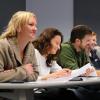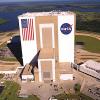Science & Technology
- <p>CIRES news release </p>
<p>The Colorado River provides water for more than 30 million people in the U.S. West, so water managers have been eager to understand how climate change will affect the river’s flow. But scientific studies have produced an unsettling range of estimates, from a modest decrease of 6 percent by 2050 to a steep drop of 45 percent by then.</p> - <p>Two University of Colorado Boulder faculty members have received prestigious CAREER Awards from the National Science Foundation.</p>
<p>NSF Faculty Early Career Development, or CAREER, Awards recognize talented young faculty members with grants to support outstanding research projects and to encourage the integration of teaching and research.</p> - <p>A Colorado student space research consortium led by the University of Colorado Boulder teamed up with a Virginia space consortium led by the University of Virginia this week to help aspiring rocket scientists from around the country learn how to design, build and fly payloads.</p>
 <p>The <a href="http://hr.colorado.edu/training/Pages/EmployeeLMC.aspx">Department of Human Resources</a> and the <a href="http://emp.colorado.edu/">Lockheed Martin Engineering Management Program</a> are excited to announce the launch of an exclusive <em>Leadership and Management Graduate Certificate Program</em>. Designed with CU-Boulder employees in mind, the program will help our current and future leaders develop and refine their leadership skills and learn new ways to measure and enhance organizational effectiveness with practical application. Course content is applicable to all professions and does not require a technical or engineering background.</p>
<p>The <a href="http://hr.colorado.edu/training/Pages/EmployeeLMC.aspx">Department of Human Resources</a> and the <a href="http://emp.colorado.edu/">Lockheed Martin Engineering Management Program</a> are excited to announce the launch of an exclusive <em>Leadership and Management Graduate Certificate Program</em>. Designed with CU-Boulder employees in mind, the program will help our current and future leaders develop and refine their leadership skills and learn new ways to measure and enhance organizational effectiveness with practical application. Course content is applicable to all professions and does not require a technical or engineering background.</p>
<p>Our employees will be able to use the tuition reimbursement benefit to cover tuition, and employees selected to participate in this exclusive program will be allowed to attend classes during work time and the employee’s department will pay for the costs of any fees and books. </p>- <p>Many photographs of the Southeast’s Smoky Mountains show layers of tall hills, shading to purples and grays in the distance. Tiny particles in the atmosphere help create the effect, which makes for stunning pictures. But human-caused enhancements of those fine particles also contribute to poor air quality in the Southeastern U.S., and may help explain why the region has not warmed like the rest of the nation.</p>
 As human population in the high-hazard ‘red zone’ skyrockets, researchers strive to understand when these homeowners perceive wildfire risk and act to mitigate it.
As human population in the high-hazard ‘red zone’ skyrockets, researchers strive to understand when these homeowners perceive wildfire risk and act to mitigate it. <p>Join us this fall for a once-in-a lifetime opportunity to be a part of CU-Boulder’s mission to Mars! The university will be hosting three fun-filled days of festivities Nov. 16-18 in Cocoa Beach, Fla., culminating in MAVEN’s launch. Space is limited for the launch viewing, and NASA requires we submit a list of tentative guests months in advance. All attendees MUST be registered with us by June 30 to be on NASA’s guest list.</p>
<p>Join us this fall for a once-in-a lifetime opportunity to be a part of CU-Boulder’s mission to Mars! The university will be hosting three fun-filled days of festivities Nov. 16-18 in Cocoa Beach, Fla., culminating in MAVEN’s launch. Space is limited for the launch viewing, and NASA requires we submit a list of tentative guests months in advance. All attendees MUST be registered with us by June 30 to be on NASA’s guest list.</p>- <p>The amount of dust being blown across the landscape has increased over the last 17 years in large swaths of the West, according to a new study led by the University of Colorado Boulder.</p>
<p>The escalation in dust emissions — which may be due to the interplay of several factors, including increased windstorm frequency, drought cycles and changing land-use patterns — has implications both for the areas where the dust is first picked up by the winds and for the places where the dust is put back down.</p> - <p>A University of Colorado Boulder professor is leading a major NASA airborne science campaign this summer that will probe weather patterns and air pollution over a vast expanse of North America that have potential global climate consequences.</p>
 <p><em>A Midsummer Night's Dream</em> kicks off the <a href="http://www.coloradoshakes.org/">2013 Colorado Shakespeare Festival</a> season, with a preview performance on Friday, June 7 and opening night on Saturday, June 8. Dream a little dream of love and laughter as Shakespeare's most beloved comedy casts its spell on the enchanting Mary Rippon stage.</p>
<p><em>A Midsummer Night's Dream</em> kicks off the <a href="http://www.coloradoshakes.org/">2013 Colorado Shakespeare Festival</a> season, with a preview performance on Friday, June 7 and opening night on Saturday, June 8. Dream a little dream of love and laughter as Shakespeare's most beloved comedy casts its spell on the enchanting Mary Rippon stage.</p>


